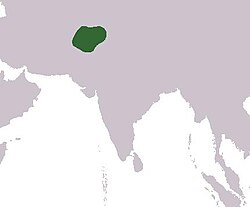Ghandara
| Gandhara | ||||||||
|
||||||||
|
Approximate boundaries of the Gandharan Empire, in northernwestern Pakistan, and northeast Afghanistan.
|
||||||||
| Capital | Not specified | |||||||
| Government | Monarchy | |||||||
| Historical era | Ancient Era | |||||||
| • | Established | 1500 BCE | ||||||
| • | Disestablished | 535 BCE | ||||||
|
||||||||
| Today part of |
|
|||||||
Gandhāra (Sanskrit: गन्धार, Punjabi: گاندهارا}, Avestan: Vaēkərəta, Old Persian: Para-upari-sena, Chinese: 犍陀罗, Greek: Παροπαμισάδαι Paropamisadae) was an ancient Indic kingdom situated in the northwestern region of Pakistan, around Peshawar. It encompassed the Peshawar valley and later extended to both Jalalabad district of modern-day Afghanistan as well as Taxila, in Pakistan. During the Achaemenid period and Hellenistic period, its capital city was Charsadda, but later the capital city was moved to Peshawar by the Kushan emperor Kanishka the Great in about 127 CE. It is mentioned in the Zend Avesta as Vaēkərəta, the sixth most beautiful place on earth, created by Ahura Mazda. It was known as the "crown jewel" of Bactria and also held sway over Takṣaśilā (modern Taxila).
Gandhara existed since the time of the Rigveda (c. 1500–1200 BC) and formed part of the Achaemenid Empire in the 6th century BC. As a center of Bactrian Zoroastrianism, animism, and later, Greco-Buddhism, and famed for its local tradition of Gandhara Art (Greco-Buddhist), Gandhara attained its height from the 1st century to the 5th century under the Kushan kings. The Persian term Shahi is used by history writer Al-Biruni to refer to the ruling dynasty that took over from the Kabul Shahi and ruled the region during the period prior to Muslim conquests of the 10th and 11th centuries. After it was conquered by Mahmud of Ghazni in 1001 AD, the name Gandhara disappeared. During the Muslim period, the area was administered from Lahore or from Kabul. During Mughal times, it was an independent district which included the Kabul province.
...
Wikipedia

